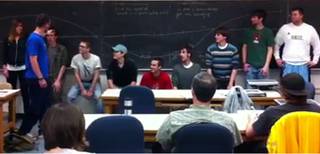You are here: start » activities » main
Emulating Waves in a Periodic System
Highlights of the activity
- Students are asked to line up at the front of the classroom and represent particles being displaced in a periodic system with repeat distance $a$.
- The instructor will represent a point in the envelope function of constant amplitude; as the instructor walks in front of the particles, each student particle will oscillate up and down to create an envelope function.
- The same process is repeated with several different wavelengths for the envelope function.
- After the first group acts out an envelope function, the class can be asked:
SWBQ: If I was moving at velocity $\frac{a}{1 \sec}$, what is the frequency at which the particles bounced up and down?
Reasons to spend class time on the activity
This exercise is a good introduction for introducing the key concepts of periodic systems, including envelope functions, eigenmodes, and dispersion relations. Any students that see the kinesthetic activity will also have a good visual representation of particles being displaced from equilibrium in a crystal. This activity can also demonstrate the physical difference between transverse and longitudinal waves by having students displace from equilibrium in different ways (up and down, left and right, back and forth).
